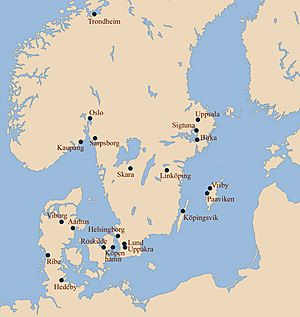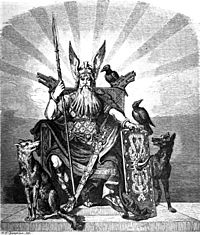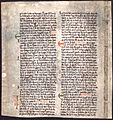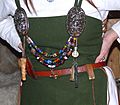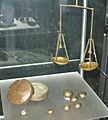Vikings facts for kids
The Vikings were a Scandinavian people from Northern Europe who were known as great seamen and warriors. From the 8th to the 11th centuries they traveled to Europe in their long ships, attacking and then settling in areas that are now modern Great Britain, Germany, France, Spain, and Italy.
Contents
Background
The people of the far north, later called Vikings, were first noticed by the Romans around the year 100 BC. This is when the Cimbri and the Teutons moved into southern Gaul. The Romans believed these war-like tribes came from Jutland. But the Romans suspected they were only a part of a greater threat located further north. The Roman historians Jordanes described the destructive Ostrogoths and Visigoths as having come from Gotland. The northern menace survived the fall of the Western Roman Empire.
The Frankish Empire that succeeded them in Gaul became more and more aware of the northern threat. As the later Carolingian Empire expanded into northern Germany they came into contact with the Danish people. This is when the Vikings first entered into written history. The first recorded raid in the west was at Lindisfarne in 793. Why the Vikings suddenly began raiding is not completely clear. But a popular theory is the populations had grown to the point there was not enough food to feed everyone. The earliest raiders did not seem to want to move out of Scandinavia. They turned to looting, then returning home. These hit and run raids were made possible because the Vikings were master boat builders and they created flat bottomed boats ideal for journeys up rivers, where many monastic sites lay, ready for plundering. This seems to indicate there was space enough for everyone. Because they found raiding so easy, it became more and more popular among the Vikings.
Three different groups of Vikings can be identified. They took three different, sometimes overlapping, routes.
- Danes raided England, Gaul, and followed the Atlantic coast of Europe south into the Mediterranean to Italy.
- Swedes went eastward into the Baltic Sea. They followed the Volga and Dnieper Rivers south as far as the Black Sea. One group, called the Rus', founded the settlement of Kiev. They called it Russland (later known as Russia).
- Norwegians raided England but preferred Ireland and Scotland. They also traveled to Greenland and about the year 1,000 AD landed at a place they called Vinland (North America).
Vikings in Europe
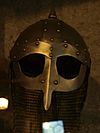
Europeans were scared of the Vikings because of their strong weapons, swift attacks, and cruel fighting tactics. They were known for their bad treatment of women, children and monks in the places where they fought. When the Vikings came to England, the English kings paid them to leave the country, but the Vikings took their money and sometimes fought them anyway. These payments were called Danegeld. From the 9th century to 1066, when the French Duke of Normandy, who became King William I of England, conquered it, Danish and Norwegian Vikings ruled large parts of England.
Because of their longships, which could float in 4 feet (1.3m) of water, the Vikings were able to make their way up rivers and land deep inside a country. For example they sailed up the River Shannon in Ireland and built a harbour 60 miles (100 km) from the coast.
There was a difference in who led Viking raids. In the 9th century Viking Age raids were led by men who may have been exiles in their own countries. The later Viking raids in the late 10th century and early 11th century and were led by Kings. Some of the early leaders tried to become kings with the riches they plundered from Europe and Russia. Some were successful but most were not.
In Russia and the Mediterranean
The Vikings were called Rus' by the peoples east of the Baltic Sea. The Vikings who settled in Kiev formed the first Russian state. The Vikings (Rus') who served the Byzantine Emperors were called Varangians. They became the personal bodyguards to the Emperor and were called the Varangian Guard.
Exploration
The Vikings traveled through Russia, the Mediterranean Sea, southern Europe, northern Africa and south-western Asia. Some Vikings sailed across the Atlantic Ocean via Iceland and Greenland and may have explored places in North America. The ruins of a Viking settlement have been found at L'Anse-aux-Meadows, Newfoundland. Archaeologists used radiocarbon dating to find out how old the settlement was. Their tests gave them a range of dates from about AD 700 to about AD 1000.
Language
Some English words, and many place names, came from the Scandinavian and Viking language (Norse). For example, the words skirt and shirt came from the word skyrta, meaning a tunic. As English changed, the semantics altered to give us the separate words 'skirt' and 'shirt' we know today. Skin came from the Norse word skinn (which meant to strip the meat off something). Some place-names in the areas the Vikings conquered are still in use.
Religion
The Anglo-Saxons called the Vikings pagans. They worshiped a great many gods. Viking gods belonged to two groups of gods in Norse mythology. They either belonged to the Aesir or the Vanir. The Aesir were gods of war. Aesir means "gods". They were the rulers of Asgard. Odin was the leader of the Aesir. He and the gods under him ruled mortal men. The vanir were wise gods skilled in magical arts. they live in Vanaheim, although nobody knows where it is. The Vanir can also predict the future. There was a war between the Aesir and the Vanir. When it ended the god Njord and his children Freya and Freyr came to live in Asgard.
The pagan Vikings were exposed to Christianity from the beginning of the Viking Age. They were surrounded by Christian countries. Early Christian missionaries were either enslaved or put to death. The Vikings came into contact with Christianity when they raided other areas around them. Viking raids produced many Christian slaves who were brought back to Scandinavia. They called Christians "Cross-men" because of the cross in their worship. In response many Vikings adopted Thors hammer as their religious symbol. When Vikings settled in Christian areas they converted to Christianity. There are still Headstones in England with both a cross and a hammer. Perhaps they thought it was better to be safe than sorry. That, or the more gods the better. As some Vikings turned from raiding to trading they found a nominal (in name only) profession of Christianity to be helpful. Scandinavia, their homeland, was slower to change to the Christian religion. But by the mid-11th century most of Norway and Denmark had converted. Sweden was converted by the mid-12th century. Overall Scandinavia and the peoples of the Baltic Sea were the last to accept Christianity.
The Viking's religion affected Christianity as well. The pagan celebration of Yuletide became Christmas along with the custom of the Christmas tree. Priests blessing the fields took the place of pagan fertility rites of spring held to make sure there was a good harvest. Norse kept their "farm gods" well after Christianity just to make sure they were protected. Santa Claus owes much of his legend to the Norse god Odin. With his snow-white beard he traveled the midwinter sky on his eight-footed steed Sleipnir visiting his people with gifts. He became Father Christmas. Blended with the Christian Saint Nicholas he (they) became Santa Claus.
In fiction and theater
In the late 19th century (1800s), Richard Wagner and other artists in the Romantic period made operas and other artwork about ancient Germanic culture. They liked the Vikings because they were not Greeks or Romans. They came up with the idea of Vikings wearing fur clothes and helmets with wings or horns on them and drinking out of hollowed-out animal horns. Some ancient Germans wore helmets with horns on them, but real Vikings did not. Wagner and his partners deliberately dressed the actors in the opera Ring des Nibelungen so they would look like ancient Germans and so the audience would feel like modern Germans came from medieval Vikings.
Related pages
Images for kids
-
Norwegian fjord
-
Blar a' Bhuailte, site of the Vikings' last stand in Skye
-
One of the few surviving manuscript leaves from the Heimskringla Sagas, written by Snorri Sturluson c. 1260. The leaf tells of King Ólafur.
-
Rook, Lewis chessmen, at the British Museum in London
-
Tim Kirk's cover painting for Robert E. Howard's Tigers of the Sea fits precisely the popular, instantly recognizable image of a Viking ship
See also
 In Spanish: Vikingo para niños
In Spanish: Vikingo para niños


